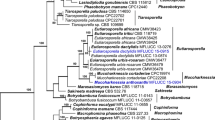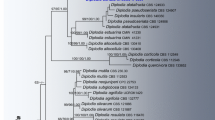Abstract
Sooty moulds often grow in colonies of more than one species, and taxonomic descriptions thus often unknowingly combine elements of different fungi. The species composition of such mixtures can be clarified by microscopic examination of undisturbed colonies removed from the substrate using the collodion technique. This method facilitates analysis of hyphal morphologies and the associations of different synanamorphs with these hyphae, i.e., the recognition of character suites that correlate with sooty mould families. Earlier versions of the International Code of Botanical Nomenclature allowed a name based on a mixture to be designated a nomen confusum, but since 1978 the Code has required selection of one species or one morph to serve as the lectotype for the name. Two binomials are revised here, with the component parts of their holotypes characterized and compared with their protologues. The type specimen of Hormiscium handelii is dominated by monilioid hyphae of a member of the Metacapnodiaceae with a hyphomycetous Capnophialophora anamorph; this latter morph is selected as the lectotype. No new combination is made because no spores were observed, so that it is impossible to adequately characterize the fungal species represented by this morph. The type of Torula lechleriana comprises three species, but it is dominated by the characteristic monilioid hyphae of a member of the Metacapnodiaceae, with Capnobotrys conidiogenous cells and conidia. The latter anamorphic fungus is chosen as the lectotype, and a taxonomic description is provided for the resulting new combination, Capnobotrys lechleriana.







Similar content being viewed by others
References
Arnaud G (1910) Contribution a l’étude des fumagines. 1 Partie (Limacinia, Seuratia, Pleosphaeria, etc.). Ann École Natl Agric Montpellier Sér 2 9:239–277
Bubák F (1909) Pilze. In von Handel-Mazzetti HF (ed) Ergebnisse einer botanischen Reise in das Pontische Randgebirge im Sandschak Trapezunt. Ann K K Naturhist Hofmus (Wien) 23:101–107
Callan BE, Carris LM (2003) Fungi on living plant substrata, including fruits. In: Mueller GM, Bills GF, Foster MS (eds) Biodiversity of fungi: inventory and monitoring methods. Elsevier, Amsterdam, pp 105–126
Gillis IM, Glawe DA (2008) Characterization of Seuratia millardetii on Camellia species and in artificial culture. N Am Fungi 7:215–229
Hughes SJ (1951) Studies on micro-fungi XII. Triposporium, Tripospermum, Ceratosporella, and Tetraposporium (gen. nov.). Mycol Pap 46:1–35
Hughes SJ (1958) Revisiones hyphomycetum aliquot cum appendice de nominibus rejiciendis. Can J Bot 36:727–836
Hughes SJ (1967) New Zealand fungi 9. Ophiocapnocoma with Hormiokrypsis and Capnophialophora states. N Z J Bot 5:117–133
Hughes SJ (1970) New Zealand fungi 14. Antennaria, Antennularia, Antennatula, Hyphosoma, Hormisciella, and Capnobotrys gen. nov. N Z J Bot 8:153–209
Hughes SJ (1972) New Zealand fungi 17. Pleomorphism in Euantennariaceae and Metacapnodiaceae, two new families of sooty moulds. N Z J Bot 10:225–242
Hughes SJ (1974) New Zealand fungi 22. Euantennaria with Antennatula and Hormisciomyces states. N Z J Bot 12:299–356
Hughes SJ (1976) Sooty moulds. Mycologia 68:293–820
Hughes SJ (1980) New Zealand fungi 31. Capnobotrys, an anamorph of Metacapnodiaceae. N Z J Bot 19:193–226
Hughes SJ (1987) Pleomorphy in some hyphopodiate fungi. In: Sugiyama J (ed) Pleomorphic fungi: the diversity and its taxonomic implications. Elsevier, Amsterdam, pp 103–139
McNeill J, Barrie FR, Burdet HM, Demoulin V, Hawksworth DL, Marhold K, Nicolson DH, Prado J, Silva PC, Skog JE, Wiersema JH, Turland NJ (eds) (2006) International Code of Botanical Nomenclature (Vienna Code). Reg Veget 146:1–568
Meeker JA (1975a) Revision of Seuratiaceae. I. Morphology of Seuratia. Can J Bot 53:2462–2482
Meeker JA (1975b) Revision of Seuratiaceae 11. Taxonomy and nomenclature of Seuratia. Can J Bot 53:2483–2496
Saccardo PA (1878) Fungi novi ex herbario Professoris Doct. P. Magnus Berolinensis. Michelia 1:117–132
Saccardo PA (1881) Fungi italici autographice delineati Fascs 17–28. Patavii, Italy Tabs 641–1120
von Höhnel F (1909) Fragmente zur Mykologie VIII. Mitteilung, Nr. 354 bis 406. Sitzungsber Kais Akad Wiss Wien Math-Naturwiss Kl Abt 1 118:1157–1246
Acknowledgments
We are grateful to the curators of DAOM, G, and PAD for the loan of specimens in their keeping. Drs. Scott Redhead and Toni Atkinson kindly provided presubmission reviews.
Author information
Authors and Affiliations
Corresponding author
About this article
Cite this article
Hughes, S.J., Seifert, K.A. Taxonomic and nomenclatural notes on sooty mould names based on species mixtures: Hormiscium handelii and Torula lechleriana . Mycoscience 53, 17–24 (2012). https://doi.org/10.1007/s10267-011-0133-4
Received:
Accepted:
Published:
Issue Date:
DOI: https://doi.org/10.1007/s10267-011-0133-4




